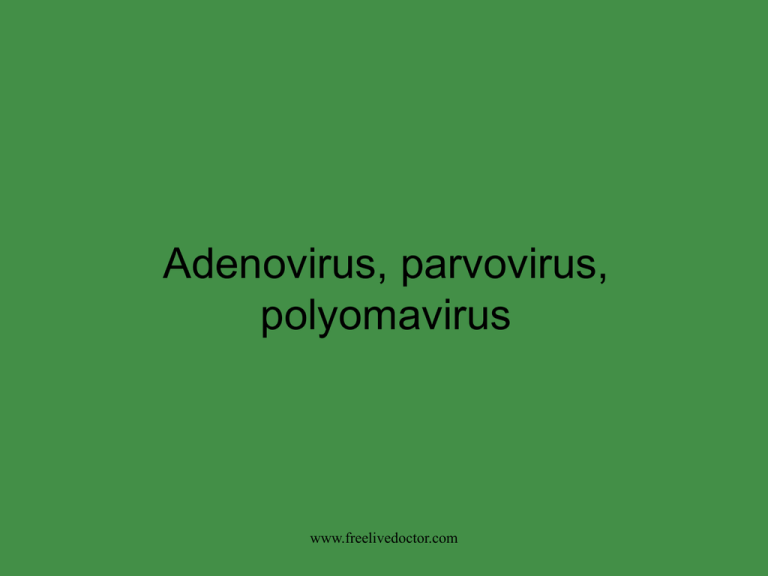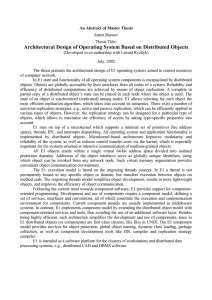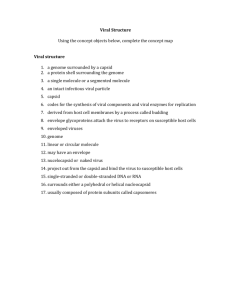Present 1
advertisement

Adenovirus, parvovirus, polyomavirus www.freelivedoctor.com Adenovirus www.freelivedoctor.com Adenovirus Structure From Medical Microbiology, 5th ed., Murray, Rosenthal & Pfaller, Mosby Inc., 2005, Fig. 53-1. www.freelivedoctor.com Adenovirus Genome Late genes E1 E2 E3 E4 36 kb linear ds DNA Early genes for host and viral transcription control, viral DNA replication Late genes for virion structure www.freelivedoctor.com Adenovirus replication cycle (From Fields Virology, 4th ed, Knipe & Howley, eds, Lippincott Williams & Wilkins, 2001, Fig. 67-5.) www.freelivedoctor.com Adenovirus diseases www.freelivedoctor.com Adenovirus pathogenesis From Medical Microbiology, 5th ed., Murray, Rosenthal & Pfaller, Mosby Inc., 2005,, Fig. 50-4. www.freelivedoctor.com Summary: adenovirus • Structure – Medium sized (36 kb) dsDNA genome, naked capsid • Pathogenesis – – – – respiratory or fecal oral transmission replication in nucleus; moderately host dependent local spread; viremia cellular and humoral immunity important; virus encodes countermeasures against MHC I expression and apoptosis – direct cell damage from replication; respiratory illness, conjunctivitis, gastroenteritis, cystitis • Diagnosis – culture, viral antigen detection • Treatment/prevention – live military vaccine www.freelivedoctor.com Parvovirus www.freelivedoctor.com Parvovirus structure www.freelivedoctor.com Parvovirus Genome ITR ITR Rep Cap 5 kb ssDNA, inverted terminal repeats (ITR) Rep gene required for DNA replication Cap gene encodes capsid proteins www.freelivedoctor.com Autonomous parvovirus replication www.freelivedoctor.com Helper dependent parvovirus (AAV) replication Infection with adenovirus Infection without adenovirus Lytic replication AAV DNA integrates into chromosome 19 Superinfect with adenovirus www.freelivedoctor.com Parvovirus pathogenesis www.freelivedoctor.com Parvovirus pathogenesis www.freelivedoctor.com Parvovirus • Structure – Small (5 kb) linear ssDNA genome, naked capsid • Pathogenesis – respiratory transmission – replication in nucleus, very host dependent, needs S phase cells or helper virus – viremia – antibody important in immunity – targets erythroid lineage cells; fifth disease (symptoms immunological); transient aplastic crisis; hydrops fetalis • Diagnosis – serology, viral nucleic acid • Treatment/prevention – none www.freelivedoctor.com Polyomavirus www.freelivedoctor.com www.freelivedoctor.com Polyomavirus genome www.freelivedoctor.com Polyomavirus replication Replication cycle of polyomaviruses. Steps in the replication cycle are indicated by numbers as follows: 1, adsorption of virions to the cell surface; 2, entry by endocytosis; 3, transport to the cell nucleus (route and mechanism not yet known); 4, uncoating; 5, transcription to produce early region mRNAs; 6, translation to produce early proteins (T antigens); 7, viral DNA replication; 8, transcription to produce late region mRNAs; 9, translation to produce late proteins (capsid proteins); 10, assembly of progeny virions in the nucleus; 11, entry of virions into cytoplasmic vesicles (mechanism unknown); 12, release of virions from the cell by fusion of membrane vesicles with the plasma membrane; 13, released virion. www.freelivedoctor.com Polyomavirus pathogenesis www.freelivedoctor.com Polyomavirus • Structure – Small (5 kb) circular dsDNA genome, naked capsid • Pathogenesis – – – – respiratory transmission replication in nucleus; very host dependent viremia persistence in kidneys; reactivation with immune compromise – inapparent infection; hemorrhagic cystitis; PML • Diagnosis – viral nucleic acid • Treatment/prevention – cidofovir ? www.freelivedoctor.com



